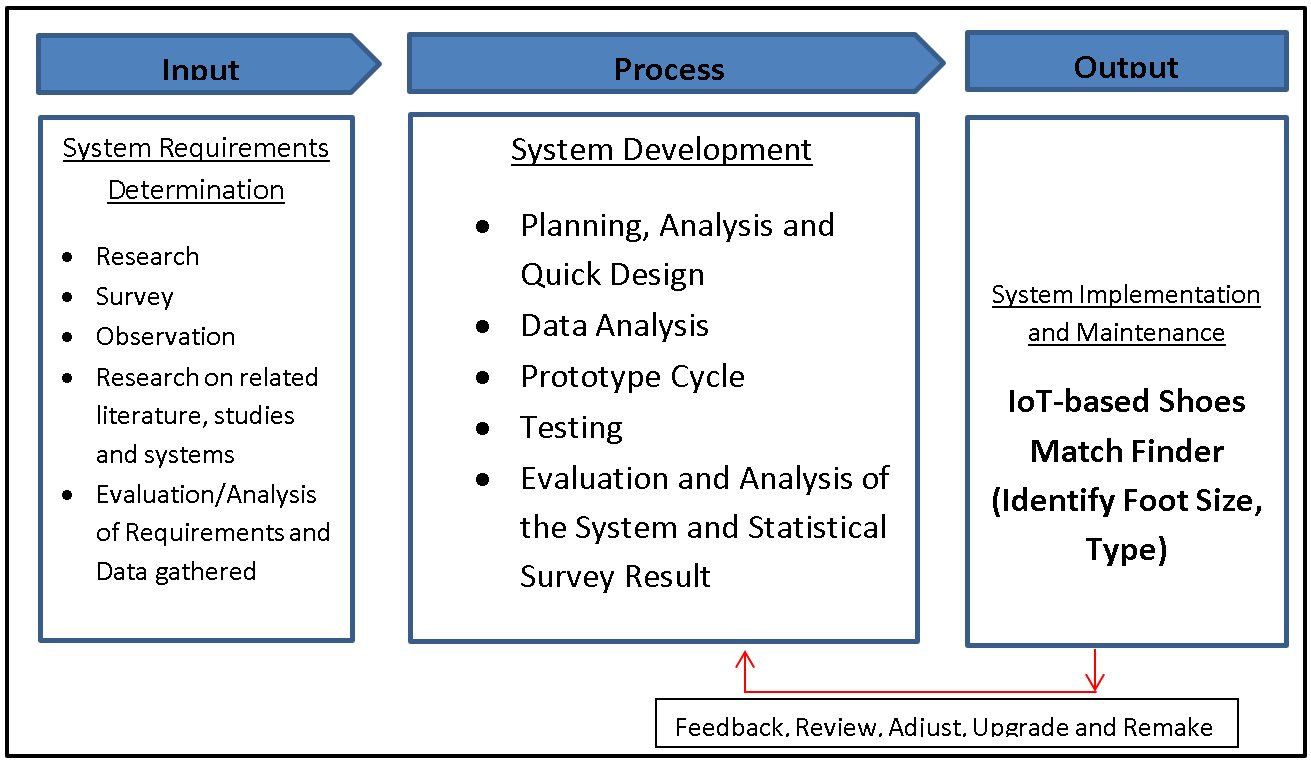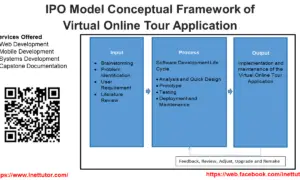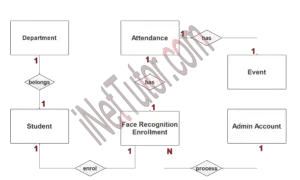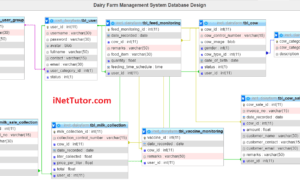IoT-based Shoes Match Finder Conceptual Framework
This post will demonstrate how to prepare a conceptual framework for a capstone project called Shoes Match Finder (Identify foot type, size) using IOT. The study’s conceptual framework was built using the input, process, and output (IPO) model.
About the Project
Table of Contents
Technology never ceases to astound us with its new solutions that make our lives easier and more convenient. The Internet of Things (IoT) is one such innovation that has made its way into our homes, cars, and even our clothing. IoT-based devices have made significant advancements in the fashion business in recent years, with one notable development being the IoT-based Shoes Match Finder, a game-changer that determines foot type and size. This cutting-edge technology is changing the way we shop for shoes by providing a personalized and efficient experience. The IoT-based Shoes Match Finder is a combination of IoT devices, sensors, and software that work together to provide a seamless and personalized shopping experience. With accurate measurements and size recommendations, customers can say goodbye to ill-fitting shoes and the discomfort they bring. By identifying foot type and size, it offers a highly personalized and efficient shopping experience, improving customer satisfaction and reducing returns. As IoT technology continues to evolve, we can look forward to even more innovative solutions that enhance our daily lives and make shopping for shoes a breeze.
Objectives of the Study
- To provide highly accurate foot measurements for each customer.
- To analyze the collected foot data to classify customers into different foot types, such as flat, neutral, or high-arched feet.
- Generate personalized shoe size recommendations based on the identified foot type and measurements.
- To visualize how different shoe styles and sizes will look on their feet, enhancing the overall shopping experience.
What is a Conceptual Framework?
A Conceptual Framework provides a structured guideline for planning and developing projects, research, or systems, serving as a roadmap for achieving desired outcomes. In the context of a capstone project, such as the development of an IoT-based Shoes Match Finder, a Conceptual Framework plays a crucial role:
- Defining Project Scope: It helps define the project’s scope by identifying the key objectives, functionalities, and constraints of the Shoes Match Finder system. This ensures a clear and focused approach to its development.
- Guiding Development Process: The Conceptual Framework guides the development process by outlining the necessary steps for designing and implementing the system. It aids in the selection of suitable IoT components, programming languages, and algorithms for creating a seamless and efficient Shoes Match Finder.
- User-Centric Approach: By emphasizing the needs and preferences of the end-users, the Conceptual Framework ensures that the Shoes Match Finder is tailored to meet the specific requirements of individuals seeking footwear solutions, thereby enhancing user satisfaction and experience.
- Research Direction: It directs the focus of research efforts toward exploring and understanding the latest trends, technologies, and customer preferences in the footwear industry. This facilitates the integration of cutting-edge features and functionalities into the Shoes Match Finder system.
- Ethical and Societal Considerations: The Conceptual Framework encourages the consideration of ethical and societal implications related to the use of IoT technologies in the footwear domain. It ensures that the system adheres to ethical standards and contributes positively to the overall well-being of the users and the community.
- Adaptability and Scalability: It facilitates the design of the Shoes Match Finder with adaptability and scalability in mind, allowing for future enhancements and modifications based on evolving customer needs and technological advancements in the footwear industry.
By employing a robust Conceptual Framework, the development team can effectively structure and guide the development of the IoT-based Shoes Match Finder, ensuring its alignment with user requirements, technological advancements, and ethical standards, ultimately resulting in the creation of a user-friendly and technologically advanced footwear recommendation system.
Conceptual Framework Diagram

The image above depicts the project’s conceptual framework, entitled IoT-based Shoes Match Finder. It is based on the input, process, and output (IPO) model.
Input
The project will begin by evaluating the present process, which will lead to the stage of doing research, survey and observation. The researchers will also need to compile relevant papers and systems to use as a guide for the project’s development. After all such process, the researchers will evaluate and analyze the requirements and data gathered.
Process
The researchers will select and choose the optimum software development life cycle model for the project in this section.
Planning, Analysis and Quick Design
During Analysis and Quick Design, the researchers did a personal interview with the respondents and the chosen client where the study was conducted. The respondents were given the chance to suggest how the system will be designed. After conducting the data gathering, the researchers made an initial design for the proposed system.
Data analysis
Consultation is used to gather requirements from end users and generate ideas. We also distributed a survey questionnaire that was authorized by three experts (IT Expert, English Grammarian, and Researcher). And these questionnaires functioned as our data gathering tool, measuring the performance of the manual system that served as the foundation for the development of our proposed system.
Prototype Cycle
This stage will consist of the researchers’ data being compiled, built, demonstrated, and refined. The researchers create a prototype first, based on the planned design and data tables. The prototype will be shown to the client after it has been built. The researchers demonstrate the system’s operation, the flow of how it operates, and the functions of the system’s features. The next stage is refining, in which the researchers will fine-tune the system based on the client’s extra requirements. Changes to the features flow and functionalities will be made based on the needs.
Testing and Evaluation
This will include the feed backing of the proposed system after it will be implemented and had undergone testing by three Experts. It will also inform the researchers and the developer if there are any bugs, suggestion and if the system’s functionality will works well.
This will discuss the implementation of the proposed system wherein Three (3) Experts will evaluate the proposed system. This will also discuss if the recommended functions and suggestion are met.
Output
The project comes to life and is executed in the real world after all of the necessary procedures have been completed. A new project is born, and it will be maintained for the project’s long-term survival.
The Output Phase of the development of an IoT-based Shoes Match Finder brings the project to fruition, resulting in tangible outcomes that contribute to the system’s successful implementation and deployment. These outcomes include:
- Functional Shoes Match Finder System: The development process culminates in the creation of a fully functional IoT-based Shoes Match Finder that effectively matches users with suitable footwear options based on their preferences, sizes, and other relevant parameters. This system is equipped with user-friendly interfaces and intuitive features that simplify the process of finding the perfect pair of shoes.
- User Training and Support: The deployment of the system includes comprehensive user training sessions that familiarize customers with the platform’s functionalities and ensure they can utilize the Shoes Match Finder effectively. Robust customer support mechanisms are put in place to address any user queries or issues that may arise during the usage of the system.
- Integration with Retailers and Manufacturers: The output phase involves establishing strong partnerships and integrations with footwear retailers and manufacturers, enabling seamless connections between the Shoes Match Finder system and the available inventory. This integration facilitates a streamlined and efficient process of recommending and purchasing shoes, benefiting both the end-users and the participating businesses.
- Continuous Monitoring and Improvement: Post-implementation, the system undergoes continuous monitoring and improvement to ensure optimal performance and user satisfaction. Regular updates and maintenance activities are conducted to address any technical issues, enhance system functionality, and incorporate new features that align with evolving user needs and technological advancements in the footwear industry.
- Enhanced Customer Experience and Satisfaction: Ultimately, the primary outcome of the Output Phase is the delivery of an enhanced customer experience and heightened user satisfaction. The IoT-based Shoes Match Finder streamlines the footwear selection process, providing users with personalized recommendations, and ensuring an efficient and convenient shopping experience, thereby fostering customer loyalty and positive brand perception.
Summary
The blog post presents an insightful exploration of the Conceptual Framework using the IPO (Input-Process-Output) model in the development of an IoT-based Shoes Match Finder. It meticulously dissects the Input Phase, shedding light on the significance of activities such as user requirements analysis, technology assessment, and risk evaluation in defining the scope and trajectory of the project. Moving to the Process Phase, the blog intricately details the integration of IoT components and the incorporation of user-friendly interfaces, ensuring a seamless and personalized experience for users seeking footwear recommendations. Finally, the Output Phase unfolds, emphasizing the successful implementation and deployment of the Shoes Match Finder system, along with user training sessions and continuous system updates to enhance performance and user satisfaction. Through this comprehensive exploration, the blog effectively demonstrates how the IPO model Conceptual Framework serves as a cornerstone in the creation of an advanced and user-centric IoT-based Shoes Match Finder, promising an enhanced and efficient footwear selection experience for customers.
Readers are also interested in:
Conceptual Framework of IoT-based Bike Anti-Theft with GPS
IoT-based Fish Pond Water Monitoring System Conceptual Framework
You may visit our Facebook page for more information, inquiries, and comments. Please subscribe also to our YouTube Channel to receive free capstone projects resources and computer programming tutorials.
Hire our team to do the project.


